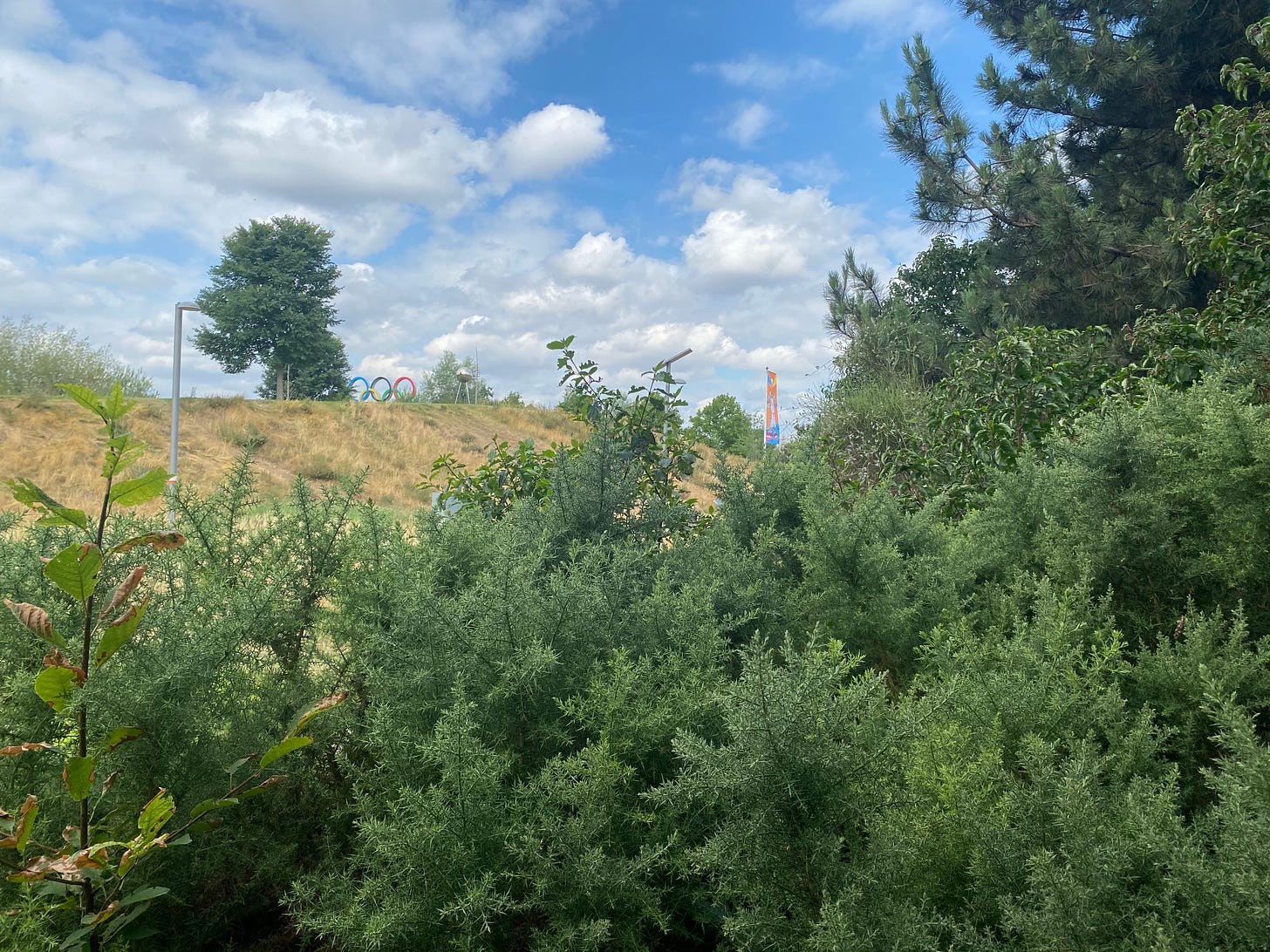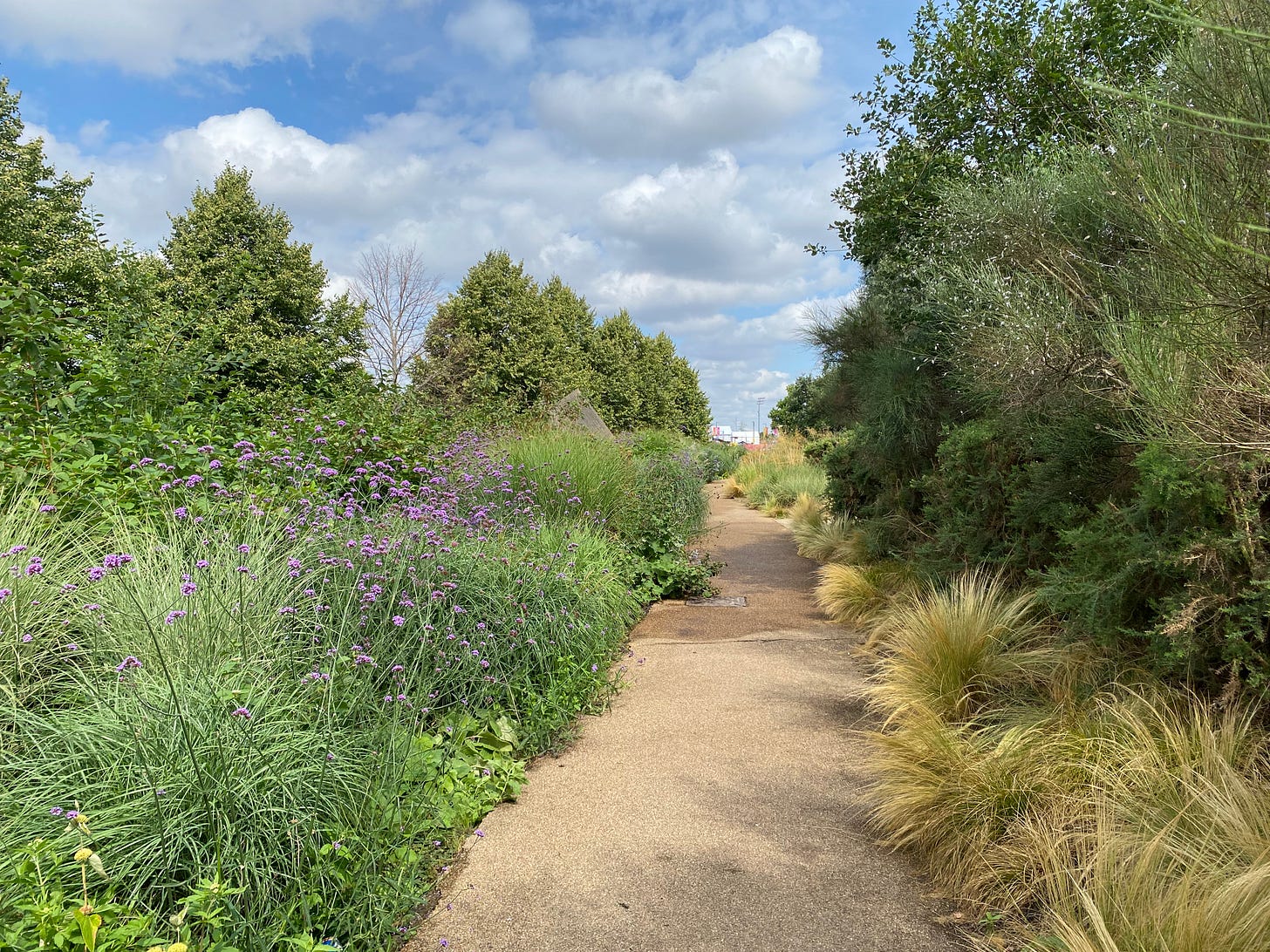On Legacy: a visit to London’s decade-old Olympic Park
The Queen Elizabeth Olympic Park is 10 years old, but how has it aged?
Thank you for reading The Earthworm. As you can hopefully imagine, a huge amount of time and thought goes into the creation every single piece I share with you here on The Earthworm. If you appreciate this work, and are able to afford it, then please consider upgrading to a paid subscription, for just a handful of British pounds each month. Your support, however you are able to express it – whether by commenting on articles, sharing posts with friends, or upgrading your subscription – is what enables me to keep The Earthworm going. Again, thanks for being here.

Ten years ago, almost to the day, marked one of the most memorable moments in (recent) British sporting history. ‘Super Saturday’ they called it, when Team GB’s Jessica Ennis-Hill, Mo Farah and Greg Rutherford brought home three track & field gold medals (heptathlon, 10,000m and long jump, respectively) at the London 2012 Olympic Games.
It was, and remains, British athletics’ most golden day. But for a lot of people, Super Saturday, and in fact that whole month of Olympic and Paralympic action, is remembered for much more than simple sporting glory and a multitude of medals. London 2012 represents, in my mind anyway, the peak of a feelgood spirit that ran right the way through British society. One that is now, sadly, only a distant memory.
For the briefest of moments, for one glorious summer, there seemed to exist the possibility of patriotism without the jingoism. Just the good bits. We were all part of Team GB. It felt inclusive, and joyful. And it’s amazing how quickly those positive feelings, those ubiquitous Union Jack flags, were co-opted, twisted and distorted by the factions who would eventually bring about Brexit – an event which, whether you were for or against, you cannot deny has been a shockingly divisive and polarising beast.

I’ve had two reasons to indulge in London Olympic nostalgia these past couple of days. First, on Sunday, we watched England’s footballing Lionesses beat Germany to be crowned European champions. The mood and tone that surrounded not just those celebrations, but the entire tournament (also, by the way, hosted here in the UK), echoed a positivity that I hadn’t experienced since 2012, and one not normally associated with the sport of football (aka soccer) which has a somewhat toxic history.
Secondly, and closer to home turf for The Earthworm, I took my son yesterday to the Queen Elizabeth Olympic Park – the epicentre of the London 2012 games – to explore and to play and to pick our first wild blackberries of the season. (I should point out that it wasn’t our first visit to the park; we’re lucky enough to have it practically on our doorstep, and so go as often as we can.)
If you can’t count yourself among the 6 million-plus annual visitors to the 100 hectare-huge park, then I thoroughly recommend you take steps to change that. It is a thoroughly modern park, a world away, in design terms, from the likes of Hyde Park or Regents Park. It has none of the antiquated formality, none of the sweeping lawns or rose gardens, marble memorials or gaudy gold-leafed statuary.
It has been designed to the Nth degree, of course, but retains a wild, or at least natural, feel. This is thanks in no small part to the planting design from a certain Nigel Dunnett (and colleagues) – a sustainability-minded, eco-conscious, naturalistic garden designer and university professor, whose status and kudos is quickly heading towards ‘genius’ level. (Dunnett is also responsible for public real transformations at The Barbican, among other locations, along with this year’s Diamond Jubilee floral extravaganza, the Tower of London SuperBloom.)
The product of one of the largest regeneration projects in London’s history, the Olympic Park (no disrespect, Queenie, but it’ll always be simply the Olympic Park to me), covers a vast area of the Lea Valley, formerly home to marshland, scrap-yards (including the infamous fridge mountain), and, let’s not forget, thousands of people.
Like all regeneration projects, it was not without its controversy, and understandably so. The Hackney and Walthamstow marshes to the north of the park remain wonderful wild spaces slicing through highly urbanised East London, and the Stratford marshes that the Olympic Park was built on had much of the same charm. Allotments were lost, a nature reserve too, and the residents displaced by the building works sacrificed their homes to make way for our feelgood summer of sport. (There’s a fun gallery of before and after shots here.)
Legacy. Perhaps the buzzword of the London Olympic bid – and one brilliantly satirised in the BBC comedy series ‘Twenty Twelve’. The Games’ organisers insisted that they be judged not purely on the success of the Olympics, but on the event’s legacy. So how did they do?
First, there’s the sporting legacy. Did London 2012 inspire a generation of youngsters to be more active? According to childhood obesity figures and sporting participation data, the answer is a resounding “no”.
Then there’s the social legacy, which is far more difficult to measure. Many new homes have been built, but are they affordable? New neighbourhoods have been created, but are they liveable? Not to mention that a massively disproportionate percentage of Team GB’s medalists from subsequent Olympics have come through the private education system, which speaks volumes about access to facilities and opportunities.
But in the Olympic Park itself, at least, the London Legacy Development Corporation1 can pat itself on the back. It is a beautiful space, full of varied landscapes and thoughtful planting that echoes the site’s past, whilst building something solid, something permanent, to last well into the future.
The banks of the River Lea are thick with reeds and willow trees; gritty, gravely paths are lined with self-seeded Viper’s bugloss; naturalistic flower borders are planted up with pollinator-friendly perennials and ornamental grasses, but also swathes of spiky wildlings like common gorse. Everywhere you look, in all of the diversely planted zones and habitats, wildflowers intermingle with garden favourites, to the extent that it’s hard to tell what is intentional and what is weed, and you are rightly reminded to question whether this distinction even matters, especially when the whole place is teeming with bees and beetles and butterflies, crickets and dragonflies and more.
Ten years on from London 2012, the park isn’t just surviving, but thriving. And it’s not only the sporting arenas themselves which are still in use but, crucially, the park itself. The playgrounds are a riot of smiling (and, let’s face it, crying) children; the cafes are doing a roaring trade; cyclists, runners, walkers, nature lovers, fishermen (fisherpeople?), foragers, sunbathers and more, utilise every available inch of what the park has to offer. When you compare these scenes to those from former venues such as the ones in Athens, Beijing or, most recently and most shockingly, Rio de Janeiro, the contrast couldn’t be more stark.
The park – its design, its planting, its diverse habitats – is one area (albeit possibly the only area) that London’s legacy lot can be proud of.
Speaking of legacy…
You may be aware of the garden creator and writer Anne Wareham, author of books including ‘The Bad Tempered Gardener’ and the best-seller ‘Outwitting Squirrels’. You may not be aware, however, that Anne has recently launched her own Substack: The Not So Bad Tempered Gardener. I wasn’t, until the lovely Jo Thompson of The Gardening Mind told me about it.
Well, in one of her first posts, titled Gifting the Ephemeral, Anne began to explore a subject that many people aren’t brave enough to confront: her legacy. Specifically as relates to the garden that she and her husband have created at Veddw [not a typo, it’s Welsh].
What will happen to Veddw after Anne and her husband have died? With no children or obvious heirs to speak of, who will look after the garden? And how? Will they keep it as it is in the moment they inherit it, as an unchanging relic, a snapshot in time? Or continue to evolve the garden and its planting design, following their own vision?
These questions clearly are nothing new, and are asked on a daily basis in National Trust boardrooms, and by the gardening teams at places like Great Dixter and Derek Jarman’s Prospect Cottage. But to follow Anne’s thought process, and to see where she and her husband land, is already fascinating and will, I’m sure, continue to be thoroughly thought-provoking.
With only a modest garden at the back of a modest terraced house in East London, I’m not sure legacy is something I need to worry about in my own space.
The trees and shrubs I plant today may outlive me, or at any rate will outlast my own tenure here, but will then be at the mercy of future occupants. They may choose to preserve what is here, or they may rip it all up and replace it with a carpet of artificial turf.
I can’t decide whether that is a depressing thought, or a freeing one, but it is certainly humbling.
The London Legacy Development Corporation. No, not a joke title lifted from Twenty Twelve – someone actually thought this was a good name.








Thanks for the mention! But what happened to all that amazing perennial planting? (https://thinkingardens.co.uk/articles/gold-at-the-olympic-park-by-bridget-rosewell/)
I had mixed feelings about the Olympics at the time but I agree the park is fantastic - a great place for cycling and as you say, no shortage of good coffee shops. I like the extensive natural elements and that the buildings are mostly of a reasonable scale and architecturally interesting. It's a good blend. Also, the fact you can seamlessly get from the park to the River Lea towpath and up to Walthamstow marshes.